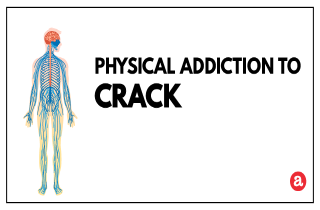The Difference Between Physical and Psychological
Crack, the pure, freebase form of cocaine is a highly addictive substance. People who often use crack can become physically dependent and addicted to the drug. In the case of addiction, it becomes unimaginable to live and/or face life’s challenges without crack.
But how do you differentiate physical dependence from addiction to crack? What signs can you look for? We explain the difference between dependence and addiction here. We’ll also list the most common physical symptoms that point to addiction. At the end, we invite your questions or comments. In fact, we try to respond personally and promptly to all legitimate inquiries.
Physical dependence on crack
In order to establish the difference between physical dependence and addiction to crack, it’s important to address the symptoms of each.
a) Crack cocaine dependence is characterized by the occurrence of crack withdrawal symptoms when you stop or lower the usual dosage. Another typical sign of dependence on crack is a need to increase dose amount or frequency over time. The pleasurable effects of crack diminish the more that you use it. This occurrence is clinically called “tolerance” to the drug and indicates that dependence has developed.
b) Addiction, on the other hand, is characterized by compulsive behavior and obsessive thinking of crack. Addiction is a psychological dependence on crack. Rather than the physical set of symptoms, it is characterized by continued use despite negative consequences in your life.
In other words, dependence has to do with the body’s need for crack, whereas addiction has to do with the mind’s needs of crack. While you can be dependent on crack, without being addicted to it, addiction is usually preceded by dependence.
NOTE HERE: Only a medical professional can determine if it’s a case of crack dependence or addiction or both, and suggest an appropriate treatment program.
Physical signs of addiction to crack
What are crack withdrawal symptoms? How can you recognize them in yourself or a loved one? To recognize if someone you know is addicted to crack, pay close attention if you may notice some of the following behavioral and physical changes:
- constantly needing money
- indifference about hobbies, friends and family
- lying and being secretive
- mood swings
- neglecting physical appearance and personal hygiene
- neglecting obligations
- red, bloodshot eyes
- sniffing
- trouble sleeping
- weary looks
- weight drop-down
Moreover, keep an eye on the symptoms that occur when the person stops or reduces the crack dose. The most common symptoms that occur as the drug withdraws from the body are:
- agitation
- depression
- fatigue
- sleep disturbances
While these symptoms are a typical sign of crack dependence, they are also present in more heavily addicted individuals. If someone you know exhibits several of these symptoms at once, chances are s/he is addicted to crack. Talk to the person and seek medical help to proceed with treatment.
Treating physical symptoms of addiction to crack
Detox clinics for physical crack addiction treatment – Crack addiction treatment typically begins with a period of detoxification during which crack cocaine and its toxins are cleared from the body. This period is oftentimes accompanied by a spectrum of withdrawal symptoms the intensity of which depends on the level of addiction. The best way to endure this stage, which can be excruciating, is under medical surveillance.
At home physical crack addiction treatment – If you consider staying at home during detox, make sure you empty your home from all crack cocaine stashes that you could possibly reach for if cravings get intense. But, detoxing from crack on your own is difficult and very likely to end with a relapse. This is why it is advised that you seek medical supervision to quit and to continue addiction rehabilitation treatment to stay quit.
Medical help for physical addiction to crack – Make sure you consult a medical professional to prescribe medications or suggest which over-the-counter meds you can use to ease or treat specific crack withdrawal symptoms. Prescription medications may be needed if you experience depression as a result of changed brain chemistry from crack. Specifically, antidepressants and anti-psychotic drugs can be prescribed during detox. A medical doctor can determine how and when to prescribe these drugs, another good reason to seek medical help during treatment.
Support and motivation for crack addicts – Having support and company from close and sober people is very welcome during the process of detoxification and recovery from physical addiction to crack cocaine. Following detox, it is recommended to continue with counseling, so you can learn how to cope with the absence of crack and eventually learn how to live without it long-term.
Physically addicted to crack questions
Does this article answer your questions and concerns about physical addiction to crack? If you have additional ones, please feel free to post them in the comments section below. We are happy to answer all legitimate inquiries personally and promptly. In the case that we don’t know the answer to your question, we will gladly refer you to someone who can help.









Related Posts